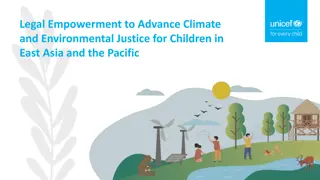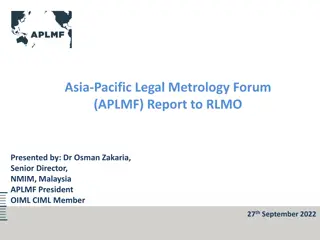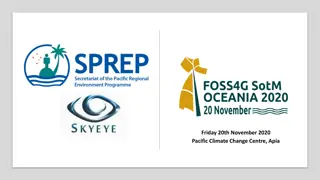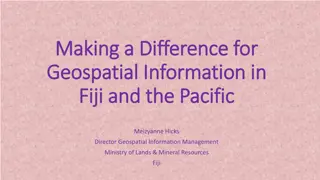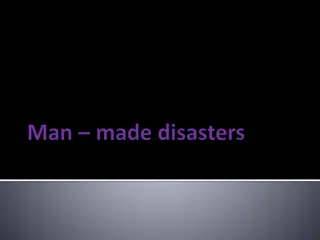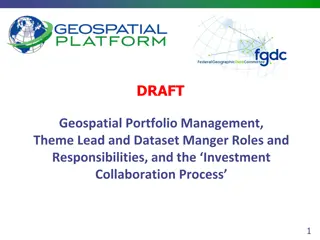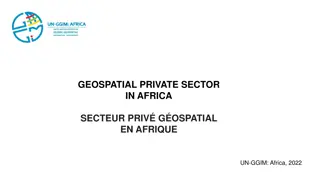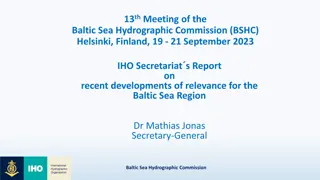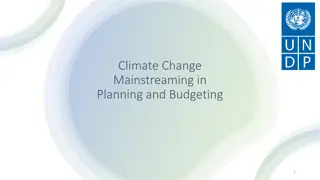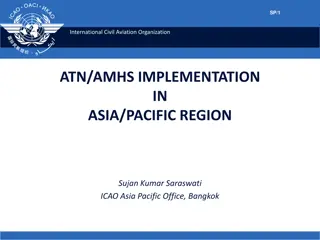Geospatial Comparison of Economic Change and Climate Disasters in Asia-Pacific
This study explores the impact of natural disasters on economic indicators in Southern and Western Asian countries over time, aiming to assist in policy-making by understanding the relationship between natural disasters and the economy. It discusses the increasing incidences of extreme weather events, the correlation between global GDP and natural disasters, and how economic effects vary across industries and countries. The research highlights the importance of considering the economic impacts of natural disasters, especially on developing countries, for effective policymaking and financial tools utilization.
Download Presentation

Please find below an Image/Link to download the presentation.
The content on the website is provided AS IS for your information and personal use only. It may not be sold, licensed, or shared on other websites without obtaining consent from the author. Download presentation by click this link. If you encounter any issues during the download, it is possible that the publisher has removed the file from their server.
E N D
Presentation Transcript
Geospatial Comparison of Economic Change and Climate Disasters in the Asia Pacific A Time-series Analysis Faiza Ahmed, MGIS GEOG 596A Advisor: Dr. Panos Giannakis
Climate Security is Financial Security Hong Kong Night Skyline (Wikipedia, 2023) The University of Rhode Island, 2023
Purpose Examine economic indicators for Southern western Asian countries over time in response to natural disasters Understanding natural disaster impact on the economy of a region will assist in better policy making (Ritchie, Rosado, and Roser 2022)
Relevant Studies: Annual incidences of extreme weather events is increasing (Keim 2020) EM-DAT Database used for extreme weather events.
World GDP Comparison to Natural Disasters World real GDP per global capita in US$ in 2015 compared to global 5 natural disaster subgroups 4 out of 5 hydrological and meteorological disasters were found to be positively correlated with GDP. As was heat, cold weather disasters. World economic growth contributing to climate change and thus more extreme weather events (Keim 2022)
Natural Disasters is a Global Phenomena 98 countries income compared from 1995 to 2019 in response to natural disasters (Khan et. al, 2023) Impact of natural disasters compared to infrastructure, and other economic indicators Income reduction effects found in all categories due to disaster related loss (Khan et. al, 2023)
Economic Effects Differ by Industry Newell (2021) compared effects of temperature on poor countries GDP and with respect to specifically agricultural growth.
Not all Disasters Affect all Countries Equally 102 countries compared (29 developed and 73 developing) (Panwar 2019) As a % of GDP, economic impacts of natural disasters stronger in developing countries Relevant for policymaking and providing other financial tools such as insurances
Why Southeastern Asia? GoGuides.com Economically diverse for a small geographic location Geographically commonalities (coastal and non-coastal countries) Disaster-prone region (Asian Development Bank, 2021) GoGuides.com
Monetary Indicators GDP (Gross domestic product) ($US) (IMF 2023) GDP (Gross domestic product) ($US) (IMF 2023) Unemployment rate (%) (IMF 2023) Debt ratio (% of GDP) (World Bank 2023) (World Bank 2023)
Datasets to be Utilized Available from 1980 to present and projected for next two years. World Economic Outlook Database: https://www.imf.org/en/Publications/WEO/weo-database/2023/April
Datasets Open Data by country (266 countries), Queried by country, indicator and time. Total 1478 indicators available to choose. One can also pick time from 1960 to 2022 https://databank.worldbank.org/source/world-development-indicators
Natural Disaster Data EM-DAT with support from WHO and Belgian Government and UN agencies Maintained by School of Public Health of the Catholic University of Louvain, located in Brussels, Belgium. 1900 to present (includes natural and technological disasters)
References Asian Development Bank. 2021. Six ways Southeast Asia strengthened disaster risk management. Asian Development Bank. https://www.adb.org/news/features/six-ways-southeast-asia-strengthened-disaster-risk-management. Botzen, W. J. Wouter, Olivier Deschenes, and Mark Sanders. The Economic Impacts of Natural Disasters: A Review of Models and Empirical Studies. Review of environmental economics and policy 13, no. 2 (2019): 167 188. Centre for Research on the Epidemiology of Disasters - CRED. 2023. The International Disaster Database. EM-DAT | The international disasters database. https://www.emdat.be/database. ESRI. 2021. Spatial Statistics Resources. ESRI Spatial Statistics Resources. https://spatialstats-analysis-1.hub.arcgis.com/. International Monetary Fund. 2023. Government Finance Statistics - IMF Data. IMF Data. https://data.imf.org/?sk=7a51304b-6426- 40c0-83dd-ca473ca1fd52. Keim, Mark E. The Epidemiology of Extreme Weather Event Disasters (1969-2018). Prehospital and disaster medicine 35, no. 3 (2020): 267 271. Keim, Mark E., Thomas More Smith, and Frederick M. Burkle. The Annual Global Incidence Rate of Extreme Weather Event Disasters Appears Positively Correlated with World GDP, 1961 2020. Prehospital and disaster medicine 37, no. 4 (2022): 431 436. Khan, Muhammad Tariq Iqbal, Sofia Anwar, Samuel Asumadu Sarkodie, Muhammad Rizwan Yaseen, and Abdul Majeed Nadeem. "Do natural disasters affect economic growth? The role of human capital, foreign direct investment, and infrastructure dynamics." Heliyon (2023): e12911.
References Hsiang, S. M., and A. S. Jina. 2014. The causal effect of environmental catastrophe on long-run economic growth: evidence from 6,700 cyclones. Working Paper 20352, National Bureau of Economic Research. Newell, Richard G., Brian C. Prest, and Steven E. Sexton. The GDP-Temperature Relationship: Implications for Climate Change Damages. Journal of environmental economics and management 108 (2021): 102445 . ORF. 2022. Exploring the Inequities of Climate Finance. ORF. https://www.orfonline.org/expert-speak/exploring-the- inequities-of-climate-finance/. Panwar, V., & Sen, S. (2019). Economic Impact of Natural Disasters: An Empirical Re-examination. Margin: The Journal of Applied Economic Research, 13(1), 109 139. https://doi.org/10.1177/0973801018800087 Ritchie, Hannah, Pablo Rosado, and Max Roser. 2022. Natural Disasters. Our World in Data. https://ourworldindata.org/natural- disasters. University of Wisconsin Madison. 2023. Southeast Asia Country Information and Resources Center for Southeast Asian Studies UW Madison. Center for Southeast Asian Studies. https://seasia.wisc.edu/southeast-asia-country-information-and- resources/. World Development Bank. 2023. World Development Indicators | DataBank. World Development Indicators | DataBank. https://databank.worldbank.org/source/world-development-indicators/preview/on. World Health Organization. 2023. Gross domestic product (GDP) per capita and GDP per capita annual growth rate. World Health Organization (WHO). https://www.who.int/data/nutrition/nlis/info/gross-domestic-product-(gdp)-per-capita-and-gdp- per-capita-annual-growth-rate.
Thank you, any questions? fna5088@psu.edu





